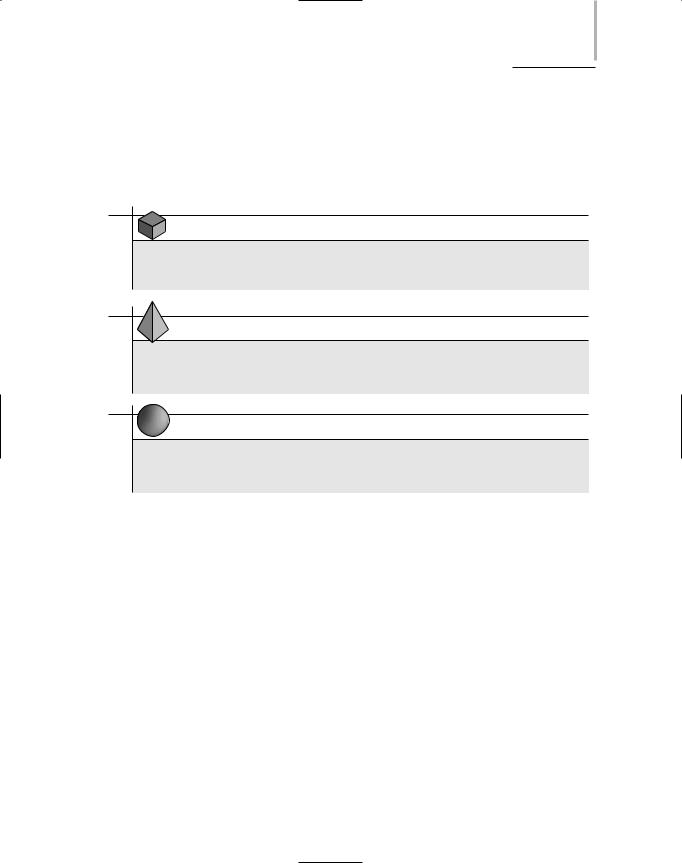
Network Plus 2005 In Depth
.pdf
xx Preface
Appendix C, “Visual Guide to Connectors,” provides a visual connector reference chart for quick identification of connectors and receptacles used in contemporary networking.
Appendix D, “Standard Networking Forms,” gives examples of forms that you can use while planning, installing, and troubleshooting your network.
Appendix E, “Answers to Chapter Review Questions,” provides the answers to the Review Questions at the end of each chapter.
CoursePrep ExamGuide
Available for download from http://www.courseptr.com/downloads, you will find PDF files containing the Network+ CoursePrep ExamGuide. This certification prep workbook provides the essential information you need to master each exam objective. The ExamGuide devotes an entire two-page spread to each certification objective from the CompTIA Network+ exam, helping you understand the objective, and giving you the bottom line information—what you really need to know. Memorize these facts and bulleted points before heading into the exam. In addition, the ExamGuide includes seven practice-test questions for each objective on the right-hand page. That’s more than 600 questions total! You can find answers to all the practice test questions in the answer key at the end of the ExamGuide, so that you can practice, drill, and rehearse for the exam.
Features
To aid you in fully understanding networking concepts, this book includes many features designed to enhance your learning experience.
Chapter Objectives. Each chapter begins with a list of the concepts to be mastered within that chapter. This list provides you with both a quick reference to the chapter’s contents and a useful study aid.
Illustrations and Tables. Numerous full-color illustrations of network media, methods of signaling, protocol behavior, hardware, topology, software screens, peripherals, and components help you visualize common network elements, theories, and concepts. In addition, the many tables included provide details and comparisons of both practical and theoretical information.
Chapter Summaries. Each chapter’s text is followed by a summary of the concepts introduced in that chapter. These summaries provide a helpful way to recap and revisit the ideas covered in each chapter.
Review Questions. The end-of-chapter assessment begins with a set of review questions that reinforce the ideas introduced in each chapter. Answering these questions will ensure that you have mastered the important concepts and provide valuable practice for taking CompTIA’s Network+ exam.

Preface xxi
Text and Graphic Conventions
Wherever appropriate, additional information and exercises have been added to this book to help you better understand the topic at hand. The following icons are used throughout the text to alert you to additional materials:
NOTE
The Note icon draws your attention to helpful material related to the subject being described.
TIP
Tips based on the author’s experience provide extra information about how to attack a problem or what to do in real-world situations.
CAUTION
The caution icons draw your attention to warnings about potential problems and explanations of how to avoid them.
All of the content that relates to CompTIA’s Network+ Certification exam, whether it’s a page or a sentence, is highlighted with a Net+ icon and the relevant objective number. This unique feature highlights the important information at a glance, so you can pay extra attention to the certification material.

Acknowledgments
As with any large undertaking, this book is the result of many contributions and collaborative efforts. It would not exist without the help of friends, family, fellow networking professionals, and Thomson Course Technology staff. Thanks to Kristen Duerr, Publisher and Executive Vice President, for her continued enthusiasm and support for the project and to Will Pitkin, Managing Editor, for his dedication and business expertise. I’m deeply grateful to Amy Lyon, Product Manager, for assembling a top-notch team and maintaining enthusiasm, order, and a steady flow of communication that allowed the project to advance smoothly. Many thanks to Ann Shaffer, Developmental Editor and friend, for handling extreme deadlines with grace and for insisting on coherence, clarity, and precision throughout each draft. With this edition, I am again indebted to Elena Montillo, Senior Production Editor, and Danielle Slade, Production Editor, who guided the book from final edits to finished product. I’m grateful also to Christian Kunciw, Quality Assurance Team Leader, and Marianne Snow, Quality Assurance tester—for scrutinizing every page and alerting me to errors and inconsistencies. Thanks to Copy Editor Karen Annett, whose close attention to details helped make the book clearer, consistent, and more pre-
cise. Thanks also to Abby Reip, who researched and obtained photos and permissions.
I’m especially grateful to Technical Editor Sydney Shewchuk who reviewed this edition for technical accuracy and made many valuable suggestions for improvement.
For additional help and advice on technical topics, I’m grateful to networking professionals Jim Berbee, Tom Callaci, Peyton Engel, Michael Grice, Carla Schroeder, Tracy Syslo, Lou Taber, and Ron Young. Special thanks to David Klann, UNIX disciple and contributing author, who generously supplied content, helped with research, and was eager to discuss the implications of non-contiguous subnetting on a Saturday night. Finally, thanks again to Paul and Janet Dean, scientists and teachers both, for their encouragement, support, and continued interest in science and technology.

Photo Credits
Figure 1-5 |
© Gary Herrington Photography |
Figure 2-6 |
Courtesy of 3Com Corporation |
Figure 3-14 |
Courtesy of VERSITRON, Inc. |
Figure 3-16 |
Courtesy of Stellar Labs (www.stellarlabs.com) |
Figure 3-19 |
Courtesy of Belden, Inc. |
Figure 3-21 |
© Gary Herrington Photography |
Figure 3-24 |
Courtesy of Optical Cable Corporation |
Figure 3-27a - d Courtesy of SENKO Advanced Components, Inc. |
|
Figure 3-29 |
Courtesy of Siemon |
Figure 3-30 |
Courtesy of Siemon |
Figure 3-43 |
Courtesy of BlackBox Corporation |
Figure 3-44 |
Courtesy of Belkin Corporation |
Figure 3-45 |
Courtesy of Belkin Corporation |
Figure 5-4 |
Courtesy of 3Com Corporation |
Figure 5-5 |
Courtesy of PCMCIA |
Figure 5-6 |
Courtesy of Linksys |
Figure 5-7 |
Courtesy of TRT Business Network Solutions |
Figure 5-8 |
Courtesy of Socket Communications |
Figure 5-9 |
Courtesy of NETGEAR; Courtesy of SMC Networks, Inc.; |
|
Courtesy of Belkin Corporation |
Figure 5-10 |
© Gary Herrington Photography |
Figure 5-11 |
© Gary Herrington Photography |
Figure 5-15 |
Courtesy of 3Com Corporation |
Figure 5-16 |
Courtesy of 3Com Corporation |
Figure 5-19 |
Courtesy of 3Com Corporation; Courtesy of Nortel Networks |

xxiv Photo Credits
Figure 5-23 Courtesy of Enterasys Networks, Inc.; Courtesy of Enterasys
Networks, Inc.; Courtesy of NETGEAR Figure 7-14 Courtesy of NETGEAR
Figure 7-16 Courtesy of Linksys
Figure 12-5 Courtesy of Agilent Technologies
Figure 12-6 Courtesy of Fluke Networks
Figure 12-7 Courtesy of Fluke Networks
Figure 12-8 Courtesy of Network Associates, Inc.
Figure 12-10 Courtesy of Fluke Networks
Figure 13-1 Courtesy of American Power Conversion Corporation Figure 13-12 Courtesy of Imation
Figure 15-6 Redrawn with permission from SolarWinds.Net

State of the Information
Technology (IT) Field
Most organizations today depend on computers and information technology to improve business processes, productivity, and efficiency. Opportunities to become global organizations and reach customers, businesses, and suppliers are a direct result of the widespread use of the Internet. Changing technology further impacts how companies do business. This fundamental shift in business practices has increased the need for skilled and certified IT workers across industries. This transformation moves many IT workers out of traditional IT businesses and into many IT dependent industries such as banking,
government, insurance, and healthcare.
In the latest Occupational Outlook Handbook from the Bureau of Labor Statistics (part of the United States Department of Labor), employment of computer support specialist is expected to increase faster than the average increase for all occupations through 2012. Job growth will continue to be driven by the continued expansion of computer system design and related services, which is projected to remain one of the fastest growing industries in the U.S. economy, despite recent job losses.
In any industry, the workforce is important to continually drive business. Having skilled workers in IT is always a struggle with ever-changing technologies. It has been estimated that technologies change approximately every two years. With such a quick product life cycle, IT workers must strive to keep up with these changes to continually bring value to their employers.
Certifications
Different levels of education are required for the many jobs in the IT industry. Additionally, the level of education and type of training required varies from employer to employer, but the need for qualified technicians remains a constant. As technology changes and advances in the industry continue to evolve rapidly, many employers look for employees that possess the skills necessary to implement these new technologies. Traditional degrees and diplomas do not identify the skills that a job applicant possesses. With the growth of the IT industry, companies are relying increasingly on technical certifications to adequately identify a job applicant’s skills. Technical certifications are a way for employers to ensure the quality and skill qualifications of their computer professionals, and they can offer job seekers a competitive edge over their competition.

xxvi State of the IT Field
There are two types of certifications, vendor-neutral and vendor-specific. Vendor-neutral certifications are those that test for the skills and knowledge required in specific industry job roles and do not subscribe to a vendor’s specific technology solutions. Some examples of vendor-neutral certifications include all of the CompTIA (Computing Technology Industry Association’s) certifications, Project Management Institute’s certifications, and Security Certified Program certifications. Vendor-specific certifications validate the skills and knowledge necessary to be successful while utilizing a specific vendor’s technology solution. Some examples of vendor-specific certifications include those offered by Microsoft, IBM, Novell, and Cisco.
As employers struggle to fill open IT positions with qualified candidates, certifications are a means of validating the skill sets necessary to be successful within organizations. In most careers, salary and compensation is determined by experience and education, but in IT field, the number and type of certifications an employee earns also determine salary and wage increases.
Certification provides job applicants with more than just a competitive edge over their non-certified counterparts applying for the same IT positions. Some institutions of higher education grant college credit to students who successfully pass certification exams, moving them further along in their degree programs. Certification also gives individuals who are interested in careers in the military the ability to move into higher positions more quickly. And many advanced certification programs accept, and sometimes require, entrylevel certifications as part of their exams. For example, Cisco and Microsoft accept some CompTIA certifications as prerequisites for their certification programs.
Career Planning
Finding a career that fits a person’s personality, skill set, and lifestyle, is challenging and fulfilling, but can often be difficult. What are the steps individuals should take to find that dream career? Is IT interesting to you? Chances are, that if you are reading this book, this question has already been answered. What is it about IT that you like? The world of work in the IT industry is vast. Some questions to ask yourself: Are you a person who likes to work alone, or do you like to work in a group? Do you like speaking directly with customers, or do you prefer to stay behind the scenes? Does your lifestyle encourage a lot of travel, or do you need to stay in one location? All of these factors influence your job decision. Inventory assessments are a good first step to learning more about you, your interests, work values, and abilities. There are a variety of Web sites that offer assistance with career planning and assessments.
CompTIA hosts an informational Web site called the TCC (TechCareer Compass™) that defines careers in the IT industry. The TCC is located at http://tcc.comptia.org. This industry-created Web site outlines over 100 industry jobs. Each defined job includes a job description, alternate job titles, critical work functions, activities and performance indicators, and skills and knowledge required by the job. In other words, it shows exactly what the jobs entail so that you can find one that best fits your interests and abilities. Addi-

State of the IT Field xxvii
tionally, the TCC maps over 500 technical certifications to the skills required by each specific job allowing you the ability to research and plan your certification training. The Web site also includes a resource section, which is updated regularly with articles and links to many other career Web sites. The TCC is the one stop location to IT career information.
In addition to CompTIA’s TCC, there are many other Web sites that cover components of IT careers and career planning. Many of these sites can also be found in the TCC Resources section. Some of these other career planning sites include: YourITFuture.com, ITCompass.net, and About.com.
CompTIA Authorized Curriculum Program
The logo of the CompTIA Authorized Curriculum Program and the status of this or other training material as “Authorized” under the CompTIA Authorized Curriculum Program signify that, in CompTIA’s opinion, such training material covers the content of the CompTIA related certification exam. CompTIA has not reviewed or approved the accuracy of the contents of this training material and specifically disclaims any warranties of merchantability or fitness for a particular purpose. CompTIA makes no guarantee concerning the success of persons using any such “Authorized” or other training material in order to prepare for any CompTIA certification exam.
The contents of this training material were created for the CompTIA Network+ certification exam objectives that were current as of March 2005.
How to Become CompTIA Certified
This training material can help you prepare for and pass a related CompTIA certification exam or exams. To achieve CompTIA certification, you must register for and pass a CompTIA certification exam or exams.
To become CompTIA certified, you must:
1.Select a certification exam provider. For more information, please visit the following Web site:
www.comptia.org/certification/itprofessionals/get_certified.aspx
2.Register for and schedule a time to take the CompTIA certification exam(s) at a convenient location.
3.Read and sign the Candidate Agreement, which will be presented at the time of the exam(s). The text of the Candidate Agreement can be found at the following Web site:
www.comptia.org/certification/general_information/candidate_agreement.aspx
4.Take and pass the CompTIA certification exam(s).

xxviii State of the IT Field
For more information about CompTIA’s certifications, such as their industry acceptance, benefits, or program news, please visit www.comptia.org/certification/default.aspx
CompTIA is a nonprofit information technology (IT) trade association. CompTIA’s certifications are designed by subject matter experts from across the IT industry. Each CompTIA certification is vendor-neutral, covers multiple technologies, and requires demonstration of skills and knowledge widely sought after by the IT industry.
To contact CompTIA with any questions or comments, please contact us at 1-630-678- 8300 or email questions@comptia.org.

Chapter 1
An Introduction to
Networking
After reading this chapter and completing the exercises, you will be able to:
■List the advantages of networked computing relative to standalone computing
■Distinguish between client/server and peer-to-peer networks
■List elements common to all client/server networks
■Describe several specific uses for a network
■Identify some of the certifications available to networking professionals
■Identify the kinds of nontechnical, or “soft,” skills that will help you succeed as a networking professional
